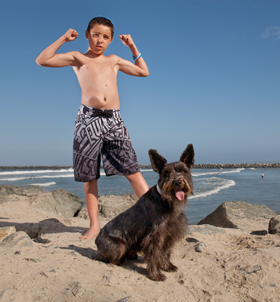
Victor Hernandez, who suffered a severe brain injury and several broken bones in a bicycling accident, enjoys time on the beach with his buddy, Tucker.
Ten-year-old Victor Hernandez is learning how to read, write and walk again. With the help of physical, speech and occupational therapy, he is making tremendous progress. Just over a year ago, Victor lay in the Ernest Hahn Critical Care Center at Rady Children’s Hospital-San Diego for nearly a month. A quick bike ride around his Lemon Grove neighborhood would leave him fighting for his life.
“He was hospitalized for three months, he was on life support for three weeks, and he was a vegetable for a month and a half after that,” said his mother, Phelicia Hopster.
Victor took that bike ride on Sept. 25, 2009, just before his school’s open house. But he never made it there. Instead, he was rushed by ambulance to the Sam S. and Rose Stein Emergency Care Center at Rady Children’s after being hit by a car. In a matter of minutes, Victor went from being a kid who excelled at school and playing sports to a critically injured child on life support.
“He was only out of the house for 8 minutes and 100 yards away,” Phelicia said. “Victor hit the windshield of the car and was thrown 35 feet from his bike. I knew instantly that he suffered a brain injury … I didn’t know if he was going to survive.”
As an X-ray technician at Rady Children’s who has dealt with trauma cases similar to her son’s, she knew immediately what to do. “I called the Hospital and told them that my son was coming and to prepare the trauma room,” Phelicia said.
When she arrived at Rady Children’s, Phelicia was met by members of the Trauma Team. The team includes attending physicians, two trauma nurses, a respiratory therapist, a social worker, a laboratory technician, a radiology technician and a pharmacist.
Victor would spend a month in the Critical Care Center and two months in the Orthopedic Rehabilitation unit. Not only did he have a brain injury, as his mom thought, but he also had a broken leg and broken facial bones. While in critical care, Brad Peterson, M.D., director of the Critical Care Center, helped reduce the swelling in Victor’s brain, Phelicia said.
Subsequently, Hal Meltzer, M.D., a pediatric neurosurgeon at Rady Children’s, implanted a Baclofen pump in Victor’s abdomen to help him with stiffness and tightness in his body due to his brain injury. “I think it has helped him with his rehabilitation and his therapies,” Dr. Meltzer said. “There is always a possibility he will improve over time [to the point] where the pump will not be needed anymore.”
Victor goes to Rady Children’s about every six months to have the pump refilled with medication. Additionally, he takes anti-seizure medication two times a day.
When Phelicia thinks about the accident, she recalls the smashed helmet at the scene — a helmet she bought at the Rady Children’s Safety Store — and is grateful that her son wore it that day.
“The helmet is the key,” she said. “If he didn’t have a helmet, there would be no way that he would have survived. The helmet saved his life.”
Sue Cox, R.N., director of Trauma and Volunteer Services at Rady Children’s, deals with trauma cases like Victor’s and stresses the importance of helmet safety for kids of all ages. “Helmets prevent 80 to 85 percent of head injuries when worn properly,” she said. “It’s important to start kids early with helmets, the first time they get on a bike — that’s a tricycle — so it’s part of their routine.”
Between January 2009 and June 2010, 37 children under the age of 15 were rushed to Rady Children’s after being hit by a car, according to the Hospital’s trauma statistics. Of these children, 24 were not wearing a helmet.
With each day, Victor continues to make great strides during his rehab sessions. Improving his balance and coordination, Phelicia said, is a major goal right now. And he has become a huge advocate for helmet safety. “He’s really open to sharing his story,” Phelicia said. “He even yells at kids and tells them to wear their helmets.”
The San Diego Union-Tribune Kids’ Newsday, October 2010